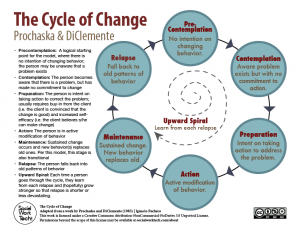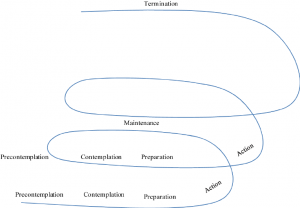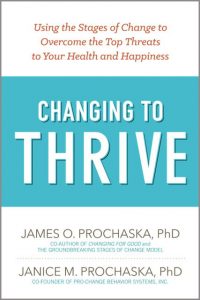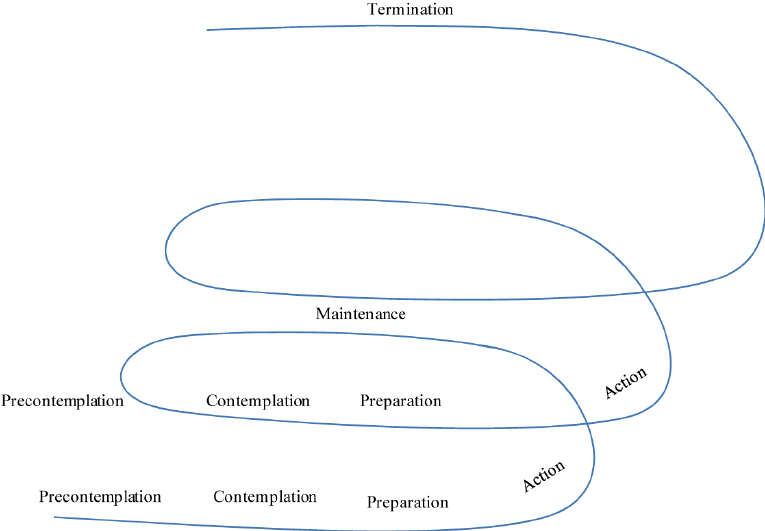 For us mere humans, behavior change is hard. Changing health behaviors is really tough. Enter Dr. James Prochaska, who has been at the forefront of researching and understanding human and health behavior for several decades. He’s the father of the Transtheoretical Model of Behavior Change (TTM).
For us mere humans, behavior change is hard. Changing health behaviors is really tough. Enter Dr. James Prochaska, who has been at the forefront of researching and understanding human and health behavior for several decades. He’s the father of the Transtheoretical Model of Behavior Change (TTM).
I have the honor today to listen live to Dr. Prochaska’s talk at the Health Integrated EMPOWER conference in St. Petersburg, Florida, where I’ll be addressing attendees on the new health consumer tomorrow.
 “Empower,” indeed. Dr. Prochaska is all about how people have good intentions to make good health decisions, but we all slip and fall and have to get back on-track. What’s underneath the slippage and bad-behavior recidivism is what Dr. Prochaska’s research has highlighted, along with how people can overcome the challenges along the journey.
“Empower,” indeed. Dr. Prochaska is all about how people have good intentions to make good health decisions, but we all slip and fall and have to get back on-track. What’s underneath the slippage and bad-behavior recidivism is what Dr. Prochaska’s research has highlighted, along with how people can overcome the challenges along the journey.
Note the first and second charts, which both illustrate the Prochaska model of transformational change. The first is the more organized, cycle concept; the second winding road looks more like how real life feels.
The steps in the TTM model are:
- Consciousness raising
- Dramatic relief
- Environmental re-evaluation
- Self-re-evaluation
- Social liberation
- Self-liberation
- Counter conditioning
- Helping relationships
- Reinforcement management, and
- Stimulus control.
The model recognizes that behavior change is a process that unfolds over time through stages — which are both stable and open for change themselves. Dr. Prochaska told us that, “the stages were taught to us by ordinary people we work with…in swamp country in Rhode Island,” learnings that had not been baked in over 150 existing theories of human behavior.
The “precontemplation stage” is a powerful place of stasis for so many of us. This is the place where we are simply not ready to make changes in our lives, and have no intention to start taking action in the next six months. This stage is often misunderstood, Dr. Prochaska has observed, being misinterpreted that people don’t want to change. But there is a big difference between “wanting” versus “intending,” he counseled. “Once you start with intent, you are prepared to pay the price.” This logic led to perhaps my favorite Dr. P quote of the day: “There is no such thing as free change,” akin to the Milton Friendman economist’s credo, “There is no such thing as a free lunch.”
The price of behavior change is time and effort, and sometimes a money cost. The risk of failure, too, is a price – in terms of opportunity cost.
Some of the common characteristics we mortals demonstrate during our precontemplation stage are ignorance (which Dr. P prefers to call, “don’t know”), demoralization, and denial.
On the “don’t know”/ignorance point, Dr. P illustrated the issue with the following headline: “Woman killed by couch. Details on the 6 o’clock news.” That is, that people with “couch potato syndrome” who under-exercise and are relatively inactive are often unaware that sitting is the new smoking, and sedentary behavior is a major risk factor for ill health. Exercise, on the other hand, can often supplant or reduce the need for certain prescription drugs that address lifestyle-borne medical conditions.
Demoralization is very common in the scenario of weight loss. “Too many people try to lose weight in too many ways, and history shows they want to change. But demoralization (due to lack of success and sustained weight loss) has people giving up, Dr. P noted.
The TTM model is not a one-size-fits-all approach and recognizes — really, respects — the individual’s personal expeirence, biases, knowledge, confidence, lens on life, at each stage on the behavior change journey. He described a long-time married couple, both mates long-time smokers. Dr. P’s team tracked the couple for two years. During the study, their dog died of lung cancer. This led to the wife quitting smoking, and the husband buying a new dog.
I could go on with many more paragraphs describing Dr. P’s research and learnings. Instead, I’ll share a few outstanding quotes that illustrate his wisdom:
“Remember the rule of Wall Street: when in doubt, don’t invest time and effort, because I have doubts this will pay off.”
“The myth is that you can devleop a new healthy behavior in 21 days…it’s actually closer to six months.” [This is the beahvioral equivalent of life-saving surgery – time to get back on one’s feet after an invasive procedure].
Folks in Canada were marketed a gambling addiction program via mass advertisements. Very few people showed up. Then Dr. P implemented a communications program on the back of public buses with the message, “Red light = not ready. Yellow light = getting ready. Green light = ready.” Prospective clients asked, “Do you mean you will work with me wherever I am at?” Dr. P’s team said, “yes,” and gained scores of more enrollees. Dr P shared one of the most satisfying conversations he heard between two fellows leaving clinic one day: one pointed to a bus on the street and said to the other, “That bus brought me here.”
“People at highest risk and highest cost tend to be in precontemplation….and we [providers tend to] judge them harshly.”
“Change talk is very important – not doing a heavy diagnosis. We want to do change talk early on (and if we do, we are) more likely to engage and more likely to succeed.”
“Digital technology is to the behavior side [of healthcare] is what pharmaceuticals are to the clinical side.” This is the evidence- based extension of counseling programs that can help people sustain the change process outside of the doctor’s office, clinic, or bricks-and-mortar institution. Clients are, “1% of the week in clinic, 99% outside.”
“Older people can indeed change. [Think of them as] not old dogs, but smart dogs.”
 Check out Dr. Prochaska’s latest book, Changing to Thrive, published in February 2017 and co-written with Dr. Janice Prochaska, who consults with Pro-Change Behavior Systems, a consultancy using the TTM methodology to improve peoples’ well-being.
Check out Dr. Prochaska’s latest book, Changing to Thrive, published in February 2017 and co-written with Dr. Janice Prochaska, who consults with Pro-Change Behavior Systems, a consultancy using the TTM methodology to improve peoples’ well-being.
For a simple explanation of the TTM, see this helpful discussion in WebMD.





 I am so grateful to Tom Lawry for asking me to pen the foreword for his book, Health Care Nation,
I am so grateful to Tom Lawry for asking me to pen the foreword for his book, Health Care Nation,  I love sharing perspectives on what's shaping the future of health care, and appreciate the opportunity to be collaborating once again with Duke Corporate Education and a global client on 6th May. We'll be addressing some key pillars to consider in scenario planning such as growing consumerism in health care, technology (from AI to telehealth), climate change, and trust -- the key enabler for health engagement or dis-engagement and mis-information. I'm grateful to be affiliated with the corporate education provider
I love sharing perspectives on what's shaping the future of health care, and appreciate the opportunity to be collaborating once again with Duke Corporate Education and a global client on 6th May. We'll be addressing some key pillars to consider in scenario planning such as growing consumerism in health care, technology (from AI to telehealth), climate change, and trust -- the key enabler for health engagement or dis-engagement and mis-information. I'm grateful to be affiliated with the corporate education provider  Thank you FeedSpot for
Thank you FeedSpot for